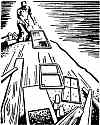 But sometimes, quinine isn't available to do its fever fighting.
Such was the case nearly 100 years ago, when the Englishman, William
Henry Perkin, set out to chemically reproduce quinine to combat a
Malaria epidemic. As one man has said "the chances for success then
were about as good as those of a carpenter who tries to build a house
at the foot of a hill by sliding shingles, rafters, doors and window
casings down from the hilltop." Perkin failed in the synthesis but he
did discover aniline purple, the first coal tar dye, and this started a
new industry.
But sometimes, quinine isn't available to do its fever fighting.
Such was the case nearly 100 years ago, when the Englishman, William
Henry Perkin, set out to chemically reproduce quinine to combat a
Malaria epidemic. As one man has said "the chances for success then
were about as good as those of a carpenter who tries to build a house
at the foot of a hill by sliding shingles, rafters, doors and window
casings down from the hilltop." Perkin failed in the synthesis but he
did discover aniline purple, the first coal tar dye, and this started a
new industry.Some years ago quinine interested an American, Edwin Land, in connection with an entirely different project. He found that by aligning crystals of quinine and iodine in a transparent plastic sheet, he could inexpensively polarize light.  Many of you have used polarizing
sun glasses based on this principle. But the new company which resulted
from this development could see that trouble in the Far East might some
day interfere with its supply of quinine. In March, 1942, their worst
fears were verified - Japan seized Java. But in the meantime they had
anticipated this event and had planned research along two lines: a
substitute polarizer made without quinine and then the more difficult
task that had baffled scientists for nearly a hundred years -
synthesizing quinine itself.
Many of you have used polarizing
sun glasses based on this principle. But the new company which resulted
from this development could see that trouble in the Far East might some
day interfere with its supply of quinine. In March, 1942, their worst
fears were verified - Japan seized Java. But in the meantime they had
anticipated this event and had planned research along two lines: a
substitute polarizer made without quinine and then the more difficult
task that had baffled scientists for nearly a hundred years -
synthesizing quinine itself. |








